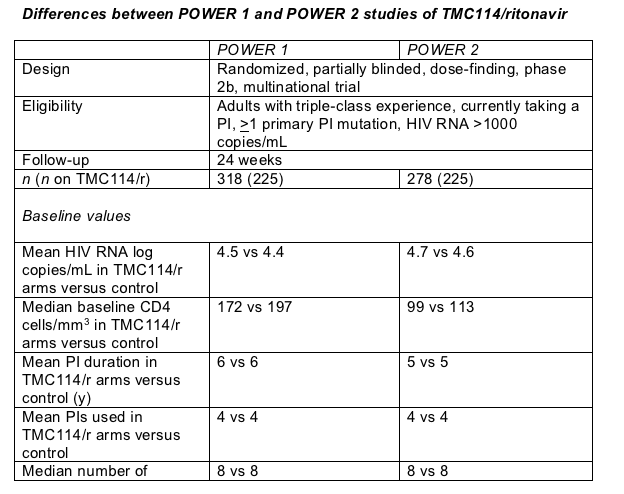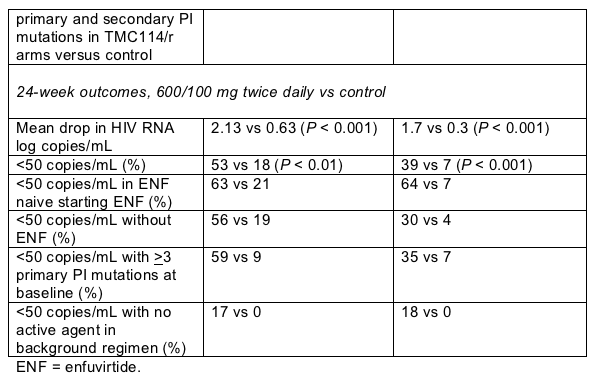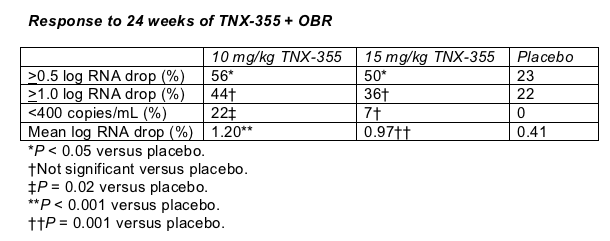 |
 |
 |
| |
News on Four New Antiretrovirals From ICAAC
|
| |
| |
Written for NATAP. A report from the 45th Interscience Conference on Antimicrobial Agents and Chemotherapy
Mark Mascolini
Long ago, people attending the Interscience Conference on Antimicrobial Agents and Chemotherapy mercifully started calling it ICAAC, which they pronounce ICK-ack. Not so long ago, this vast infectious disease meeting featured an opening session on HIV infection and lots of slide talks on managing the wily retrovirus.
Of late, though, the HIV slice of ICAAC's pie has assumed weight-watchers' proportions. The 2005 edition, for example, featured a single slide-session serving on HIV and smaller helpings of clinically critical posters.
But this year's conclave (transplanted to Washington, DC, after savvy planners originally slotted space in New Orleans during peak hurricane season) did offer useful looks at four investigational antiretrovirals, fresh insights on antiretroviral strategies and side effects, three important studies of antiretroviral interactions with TB-thwarting rifamycins, and a clutch of findings on coinfection with HBV and HCV.
This serial review starts with the four new drugs.
New Glaxo PI in naive and experienced people
Few had heard of brecanavir, a protease inhibitor (PI) with some novel features, until DC clinician Douglas Ward outlined 24-week results from an ongoing nonrandomized study of people starting the drug with a ritonavir boost and two nucleosides [1]. Brecanavir reined in viral replication in people with and without PI-resistant virus, spawning side effects typical of the PI class.
Cell studies suggest brecanavir exerts up to 100 times the antiviral activity of licensed PIs, though what happens in lab dishes does not always reflect what happens in people. The Glaxo drug, being codeveloped with Vertex, has at least one other alluring attribute—it does not inhibit or induce CYP3A4, the enzyme critical to metabolism of current PIs and an array of other drugs taken by people with HIV. That probably would mean fewer vexing drug-drug interactions if brecanavir reaches the market.
Ward and confreres signed up 25 men and 6 women to start brecanavir/ritonavir at 300/100 mg twice daily plus two nucleosides from a preset list: AZT, ddI, d4T, 3TC, or emtricitabine (FTC), but not tenofovir. The group began treatment with a median viral load of 4.71 log copies/mL (about 51,000 copies/mL) and a median CD4 count of 311 cells/mm3.
Six people who already had PI-resistant virus carried a median of seven primary PI mutations (range 4 to 9) and 5 nucleoside-induced mutations (range 1 to 6). Compared with the whole study group, these people had a lower median viral load (3.98 log or about 9500 copies/mL) and a higher median CD4 count (389 cells/mm3) when they entered the trial.
An intent-to-treat analysis that counts missing data as a failure determined that 25 of 31 people (81%) had a viral load below 400 copies/mL at week 24, and 24 (77%) made it below the 50-copy mark. Median viral loads dropped 3.3 log in people starting brecanavir with PI-sensitive virus and 2.2 log in people with PI mutations. But people with PI mutations had lower viral loads at study entry, so their HIV RNA had a shorter way to fall into undetectable realms.
Four people dropped out of the study before week 24, two of them because of side effects—nausea and vomiting in one and a grade 3 liver enzyme surge in a person coinfected with HCV. Ten people (32%) endured at least one side effect during the study's first 24 weeks, with fatigue the most common in 4 (13%).
Grade 3 or 4 lab abnormalities included creatine phosphokinase elevations (a marker of kidney troubles) in 3 people (10%), high triglycerides in 2 (6%), and jumps in the liver enzymes aspartate aminotransferase (AST) in 1 and gamma-glutamyltransferase in another. Average total cholesterol rose 30.9 mg/dL.
Ward and colleagues couldn't use tenofovir in this study because its interactions with brecanavir had not been studied. In a separate trial involving 35 healthy, HIV-negative volunteers, Glaxo researchers found that 300/100 mg of brecanavir/ritonavir twice daily boosted tenofovir's area under the concentration-time curve (AUC) 32% while lifting its peak concentration 24% [2]. Brecanavir's AUC rose 15% with tenofovir and its peak 17%, while ritonavir's AUC and peak climbed 39% and 33% with tenofovir.
The Glaxo team concluded that this investigational dose of brecanavir would not have to be trimmed with tenofovir, though they caution clinicians may have to watch more closely for side effects. One healthy volunteer did drop out of this interaction study because of high creatinine readings, not a rare problem with tenofovir and—as Ward's findings suggest—perhaps not with brecanavir.
Glaxo has not settled on the 300/100-mg twice-daily dose. A dose-ranging study will enroll 130 people with one or more major PI mutations.
Understanding TMC114 power against resistant HIV
This year's ICAAC afforded a 24-week look at results of the POWER 2 trial pitting TMC114/ritonavir against a standard PI salvage regimen in people with plentiful PI experience.
But wait. Haven't we already heard 24-week POWER 2 results? Or was that POWER 1?
Both, as it turns out. In February 2005, at the Conference on Retroviruses, Richard Haubrich spelled out findings on 497 people enrolled in either POWER 1 or 2 [3]. Twenty-six weeks later, Christine Katlama gave a more focused look at POWER 1 results, but still only 24 weeks' worth [4]. At ICAAC, 46 weeks after Haubrich's talk, Timothy Wilkin from the University of California, San Diego, homed in on a still-maturing 24-week data set from POWER 2 [5]. Perhaps Tibotec, maker of this potent PI, will unveil 48-week data at next February's Retrovirus get-together.
Both POWER studies randomized people with triple-class experience and at least one major PI mutation to take one of four TMC114/ritonavir doses or the best-feasible PI-based control regimen. The protocols blinded researchers to the TMC114 dose.
Wilkins' POWER 2 enrollees had more advanced HIV infection than their POWER 1 counterparts (Table), but the two study groups had similar PI experience and equivalent resistance to PIs.


The more advanced disease in POWER 2 than in POWER 1 may figure in the more modest 24-week virologic response—a 1.7-log copies/mL drop with the highest dose of TMC114/ritonavir (600/100 mg twice daily) in POWER 2 versus 2.13 log copies/mL in POWER 1. And a lower proportion in POWER 2 than in POWER 1 (39% versus 53%) had a 24-week viral load under 50 copies/mL in an intent-to-treat analysis. Both responses in the TMC114 groups handily exceeded 24-week RNA wanings in the control arms.
People in POWER 2 also got less from 600/100 mg of TMC114/ritonavir than POWER 1 enrollees if they had three or more primary mutations, if they did not mix the fusion inhibitor enfuvirtide into their regimen, or if they had no other active agent in their background regimen (Table). But among enfuvirtide-naive people starting that drug, POWER 2 participants did as well as POWER 1 enrollees. By all these measures, TMC114/ritonavir worked much better than control PI regimens. Phase 3 studies will use the 600/100-mg twice-daily dose.
Daniel Berger from Chicago's Northstar Medical Center detailed side effect findings in POWER 2, reporting that 8% quit the TMC114/ritonavir arms because of side effects versus 4% in the control arm [6]. The primary reason for that between-arm difference appears to be that people dropped out of the control group because of virologic failure before they could quit because of side effects. By week 24 the virologic failure dropout rate measured 47% with standard PI salvage regimens versus 9% with TMC114/ritonavir.
More than one quarter of POWER 2 participants taking the new PI had grade 3 or 4 problems (32% in the 600/100-mg arm), and 15% had a "serious adverse event" (9% in the 600/100-mg arm). Rash was the most common clinical problem with TMC114/ritonavir, affecting 5%. AST elevations, in 4%, were the most frequent lab abnormality.
Ten-fold RNA drop with 10 days of PA-457 solo
PA-457, the first HIV maturation inhibitor, squelched viral replication in a 10-day monotherapy comparison with placebo [7]. This pill prevents HIV's core proteins from maturing, and that makes new viral particles noninfectious. With a half-life approximating 60 hours, PA-457 seems a shoo-in once-daily candidate.
The monotherapy study, presented by George Beatty from the University of California, San Francisco, enrolled 33 people who had never taken antiretrovirals or had been off treatment for at least 12 weeks. Beatty and colleagues at other sides randomized them to placebo or to 25, 50, 100, or 200 mg of PA-457 once a day.
Before treatment began the group's median viral load stood at 4.73 log copies/mL (about 51,000 copies/mL) and their median CD4 count at 441 cells/mm3. Thirteen people had antiretroviral experience, but resistance was moderate. No one in the 100- or 200-mg PA-457 arms had virus resistant to PIs.
On day 11, after 10 days of treatment, viral loads changed hardly at all in the placebo and 25-mg arms. Compared with placebo, median viral loads dropped significantly with 50 mg of PA-457 (-0.17 log, P = 0.02), 100 mg (-0.48 log, P = 0.004), and 200 mg (-1.03 log, P < 0.0001). Among people with a baseline viral load below 100,000 copies/mL, median RNA falloffs measured 0.56 log with 100 mg of PA-457 and 1.52 log with 200 mg.
Response rates did not differ in people with and without antiretroviral experience. One person who never took antiretrovirals had essentially no response to 200 mg of PA-457 daily (-0.07 log) for reasons that remain unclear. This person did attain good plasma levels of the maturation inhibitor. Overall, PA-457 level proved the best correlate of virologic response.
Beatty suggested that 200 mg daily may not be the maximum tolerated dose of this novel compound. No grade 3 or 4 lab abnormalities emerged during this brief study. One person had a grade 2 triglyceride jump on day 5, but that reading returned to normal by day 10.
One person with poorly controlled hypertension suffered a lacunar stroke during the trial. But Beatty noted that PA-457 could not be eliminated as a contributor. According to the Massachusetts General Hospital Stroke Service, lacunar strokes "tend to occur in patients with diabetes, hyperlipidemia, smoking or chronic hypertension" [8].
Who will use TNX-355?
Optimized background regimens (OBR) endured another blow in a randomized comparison with OBR plus TNX-355, a humanized monoclonal antibody that binds to CD4 receptors on T cells and keeps the virus out [9]. This drug stifles replication of virus that uses either of HIV's primary coreceptors, CCR5 or CXCR4, and it has antiviral synergy with enfuvirtide [10].
But TNX-355 has one big drawback: With the current formulation, people must take it by infusion every week or every other week, a feature that would make it less convenient than enfuvirtide and probably restrict its use to deep salvage regimens.
This phase 2 study recruited 82 people with triple-class experience to take placebo plus an OBR or an OBR with one of two TNX-355 doses—15 mg/kg infused every 2 weeks or 10 mg/kg weekly for 8 weeks followed by 10 mg/kg every other week.
Baseline viral loads averaged 4.78 log in the 10 mg/kg group, 5.00 log in the 15 mg/kg group, and 4.83 log in the placebo arm (4.8 log is about 63,000 copies/mL; 5 log is 100,000 copies/mL). While 33% in the placebo group and 26% in the 10-mg/kg group had a starting viral load above 100,000 copies/mL, 57% in the 15-mg/kg group began treatment with a 6-figure viral load. Baseline viral loads averaged 299 cells/mm3 in the 10-mg/kg arm, 223 cells/mm3 in the 15-mg/kg arm, and 246 cells/mm3 among those assigned to placebo.
Norris and coworkers did not report relative antiretroviral experience in the three study arms, so there's no way to know whether treatment histories differed from group to group or how those histories may have affected outcomes.
Defining virologic failure as failure to cut the viral load at least a half-log at or after week 16, these researchers charted significantly fewer failures with 10 mg/kg of TNX-355 (in 11 of 27 people, 40%, P = 0.003 versus placebo) or 15 mg/kg of the CD4 blocker (in 10 of 28 people, 34%, P = 0.001 versus placebo) than with an OBR alone (in 20 of 27 people, or 74%). Other 24-week virologic measures suggested a somewhat better response with 10-mg/kg infusions than with the 15-mg/kg regimen (Table).

Five serious clinical problems arose in the trial, but the researchers attributed none of them to TNX-355: bradycardia (slow heart rate), liver failure, maculopapular rash, depression with an episode of acute abdominal pain, and acute renal failure. The people with liver failure and rash had to drop out of the study; the others did not. All of these episodes resolved or stabilized.
TNX-355 did not deplete CD4 cells, a concern with a monoclonal antibody that plugs this T-cell receptor. In fact, average CD4 counts inched upward while people took TNX-355.
Mark Mascolini writes about HIV infection
References
1. Ward D, Lalezari J, Thompson M, et al. Preliminary antiviral activity and safety of 640385/ritonavir in HIV-infected patients (study HPR10006): an 8-week interim analysis. 45th Interscience Conference on Antimicrobial Agents and Chemotherapy. December 16-29, 2005. Washington, DC. Abstract H-412.
2. Ford SL, Shelton MJ, Murray SC, et al. A study to investigate the interaction between 640385/ritonavir and tenofovir in healthy subjects. 45th Interscience Conference on Antimicrobial Agents and Chemotherapy. December 16-29, 2005. Washington, DC. Abstract A-1198.
3. Katlama C, Berger D, Bellos N, et al. Efficacy of TMC114/r in 3-class experienced patients with limited treatment options: 24-week planned interim analysis of 2 96-week multinational dose-finding trials. 12th Conference on Retroviruses and Opportunistic Infections. February 22-25, 2005. Boston. Abstract 164LB.
4. Katlama C, Carvalho MTM, Cooper D, et al. TMC114/r outperforms investigator-selected PI(s) in 3-class-experienced patients: week 24 primary efficacy analysis of POWER 1 (TMC114-C213). 3rd IAS Conference on HIV Pathogenesis and Treatment. July 24-27, 2005. Rio de Janeiro. Abstract WeOaLB0102.
5. Wilkin T, Haubrich R, Steinhart CR, et al. TMC114/r superior to standard of care in 3-class-experienced patients: 24-wks primary analysis of the Power 2 study (C202). 45th Interscience Conference on Antimicrobial Agents and Chemotherapy. December 16-29, 2005. Washington, DC. Abstract H-413.
6. Berger DS, Bellos N, Farthing C, et al. TMC114/r in 3-class-experienced patients: 24-wk primary safety analysis of the Power 2 study (C202). 45th Interscience Conference on Antimicrobial Agents and Chemotherapy. December 16-29, 2005. Washington, DC. Abstract H-1094.
7. Beatty G, Lalezari J, Eron J, et al. Safety and antiviral activity of PA-457, the first-in-class maturation inhibitor, in a 10-day monotherapy study in HIV-1 infected patients. 45th Interscience Conference on Antimicrobial Agents and Chemotherapy. December 16-29, 2005. Washington, DC. Abstract H-416d.
8 Massachusetts General Hospital Stroke Service. Management algorithm: lacunar stroke.
http://neuro-oas.mgh.harvard.edu/stopstroke/lacunar_stroke.htm#clinical_lacunar.
9. Norris D, Morales J, Gathe J, et al. TNX-355 in combination with optimized background regimen (OBR) exhibits greater antiviral activity than OBR alone in HIV treatment experienced patients. 45th Interscience Conference on Antimicrobial Agents and Chemotherapy. December 16-29, 2005. Washington, DC. Abstract LB2-26.
10. Godofsky E, Zhang X, Sorenson M, et al. In vitro antiretroviral activity of the humanized anti-CD4 monoclonal antibody, TNX-355, against CCR5, CXCR4, and dual-tropic isolates and synergy with enfuvirtide. 45th Interscience Conference on Antimicrobial Agents and Chemotherapy. December 16-29, 2005. Washington, DC. Abstract LB-26.
|
|
| |
| |
|
 |
 |
|
|